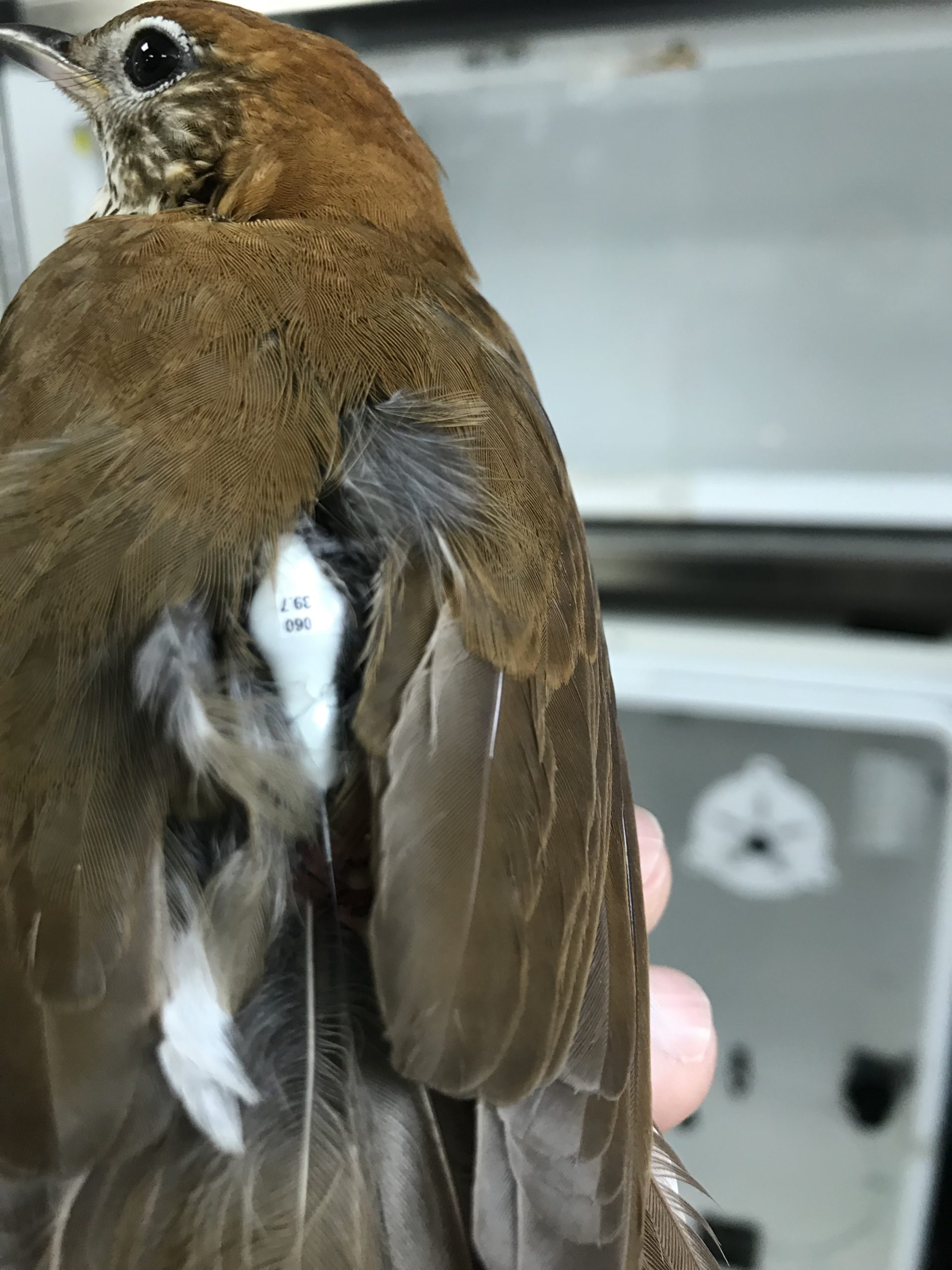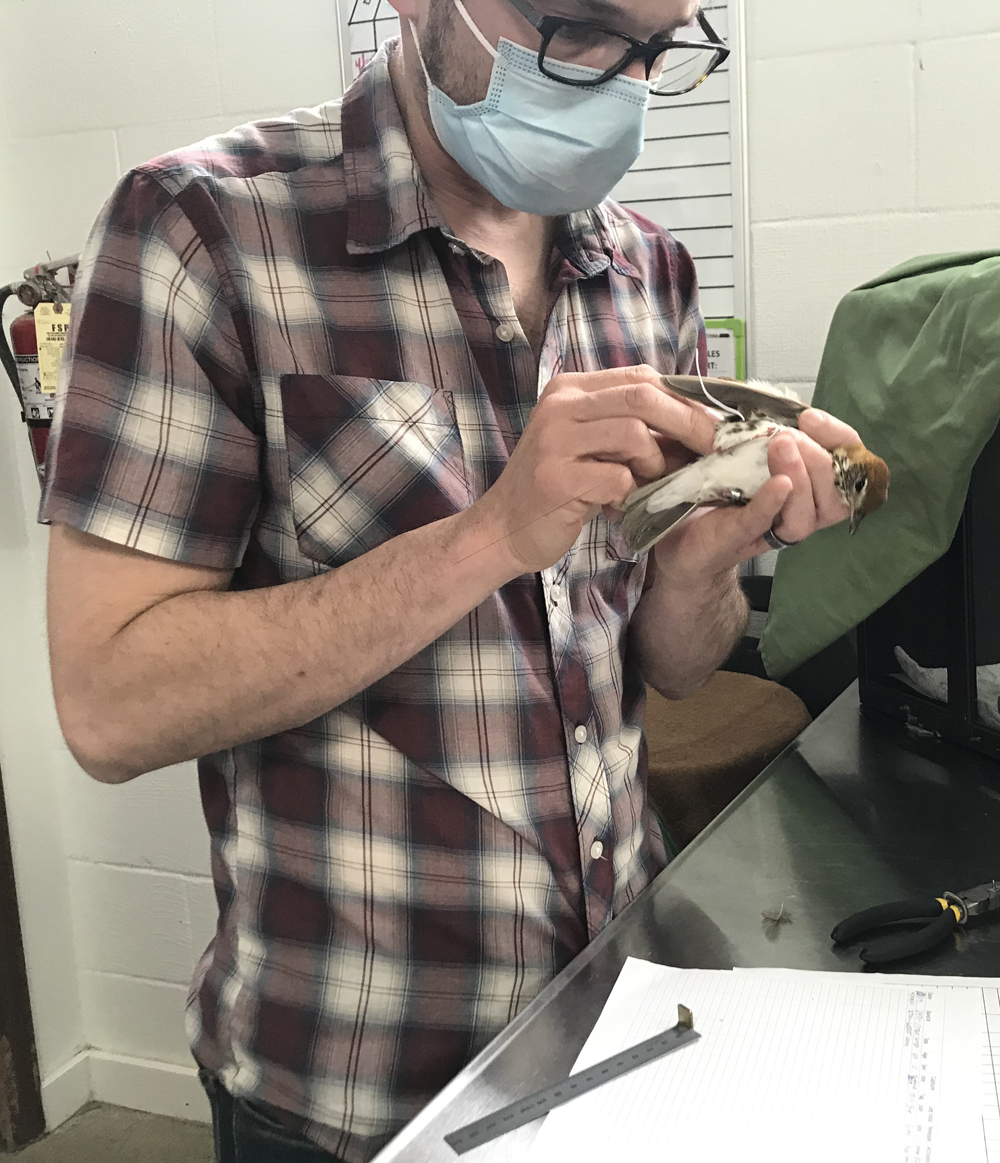It Was Rescued by Lights Out Columbus Volunteers After a Downtown Collision

A migrating Wood Thrush injured in a downtown window collision was rescued by Lights Out volunteers April 27 and later fitted with a nanotag to track its journey to summer habitats. The Wood Thrush was only the second bird rescued in several years of Lights Out monitoring to have a nanotag placed before being released back to its migration pathway.
Lights Out is a community-wide effort directed by Ohio Wildlife Center to decrease the hazards to birds during migration seasons, such as urban light pollution, window strikes and skyscraper collisions. During the spring monitoring, groups of Center volunteers walk early morning routes through downtown streets to rescue injured neotropical birds.
The Wood Thrush spent a day at the Wildlife Hospital for care after the window strike, receiving an exam, nutrition, fluids and rest. After being fitted with the nanotag, which is a tiny radio transmitter that sends unique signals to Motus station receiver towers crossing from Canada to South America, the bird was released at the Columbus Zoo Wildlife area on April 28.
The data obtained using nanotags applies to songbirds, particularly those that are endangered, threatened or a species of concern. A Motus antenna is located at the Columbus Zoo and Aquarium and one is also at the Wilds Safari Park in Muskingum County. The Zoo’s Conservation Fund provided funding for Lights Out Columbus and the purchase of the nanotags.
“The data tracked by the Motus towers from the tagged birds is essential for researchers to compile information about how the rescued birds do after building or window collisions when they are treated and released back to continue seasonal migration,” said Stormy Gibson, Lights Out Columbus project director.
According to Matt Shumar, program coordinator for the Ohio Bird Conservation Initiative who installed the nanotag, the Wood Thrush was tagged as part of a study being conducted by the Powdermill Avian Research Center. “This study has focused only on Wood Thrush and American Woodcock, species we encounter frequently during our collision surveys and are large enough to wear larger tags,” Shumar noted. “Twenty-one American Woodcock were tagged this year in Cleveland as part of the study and the Wood Thrush was the only bird from Columbus this year that was tagged,” he said.

“This data will provide rehabilitators, conservation organizations and researchers with a base of knowledge of movement, rate of stop over and other critical information about migrating songbirds,” Gibson added. “The wildlife tracking data will be useful to understand the importance of release location, wildlife movement and the importance of Neotropical migratory songbirds as indicator species in our natural environment,” she said.
Shumar said the Columbus Zoo Motus tower picked up the Wood Thrush nanotag signals for five days after its release.
“There aren’t many towers in northern Ohio aside from a couple in Cleveland and some on the western Lake Erie basin,” he said. “It’s possible the bird either settled into a breeding territory somewhere in northern Ohio or continued north into Canada without passing any towers.”
Wood Thrush are trans-gulf migrants, wintering in Central America and southern Mexico. They fly directly north across the open water of the Gulf of Mexico during spring migration. Once in the U.S. they fill in forests east of the Great Plains and breed where there are large trees and abundant leaf litter for foraging.
“The opportunity to place this nanotag is an exciting collaboration for Lights Out Columbus with the Columbus Zoo, Powdermill Avian Research Center, the Ohio Bird Conservation Initiative and all the conservation organizations across Ohio,” Gibson said.